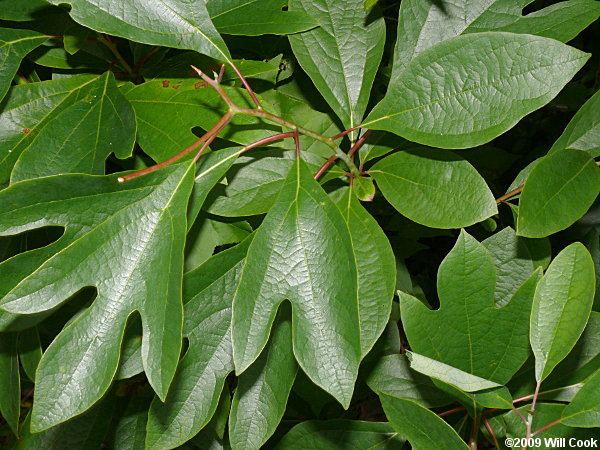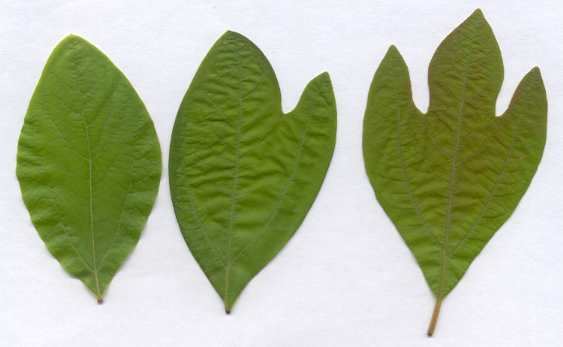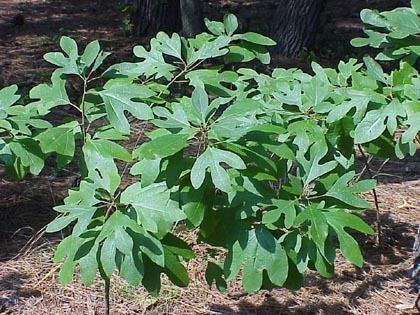Scientific name Sassafras Rank Genus | ||
 | ||
Similar Lauraceae, Oak, Hickory, Maple, Pine | ||
Sassafras is a genus of three extant and one extinct species of deciduous trees in the family Lauraceae, native to eastern North America and eastern Asia. The genus is distinguished by its aromatic properties, which have made the tree useful to humans.
Contents
- Name
- Description
- Habitat and range
- Importance to wildlife
- Species
- North America
- East Asia
- Human uses
- Culinary uses
- Medicinal uses
- Uses of wood
- Oil and aromatic uses
- Exploitation and commodification
- References

Name

The name "sassafras", applied by the botanist Nicolas Monardes in 1569, comes from the French sassafras. Some sources claim it originates from the Latin saxifraga or saxifragus: "stone-breaking;" saxum "rock" + frangere "to break"). Early European colonists reported that the plant was called winauk by Native Americans in Delaware and Virginia and pauane by the Timucua. Native Americans distinguished between white sassafras and red sassafras, which terms referred to the same plant but to different parts of the plant with distinct colors and uses. Sassafras was known as fennel wood (German Fenchelholz) due to its distinctive aroma.
Description

Sassafras trees grow from 9–35 m (30–115 ft) tall with many slender sympodial branches, and smooth, orange-brown bark or yellow bark. All parts of the plants are fragrant. The species are unusual in having three distinct leaf patterns on the same plant: unlobed oval, bilobed (mitten-shaped), and trilobed (three-pronged); the leaves are hardly ever five-lobed. Three-lobed leaves are more common in sassafras tzumu and sassafras randaiense than in their North American counterparts, although three-lobed leaves do sometimes occur on sassafras albidum. The young leaves and twigs are quite mucilaginous, and produce a citrus-like scent when crushed. The tiny, yellow flowers are five-petaled; sassafras albidum and sassafras hesperia are dioecious, with male and female flowers on separate trees, while sassafras tzumu and sassafras randaiense have male and female flowers occurring on the same trees. The fruit is a drupe, blue-black when ripe.

The largest known sassafras tree in the world is located in Owensboro, Kentucky, and measures over 100 feet high and 21 feet in circumference.
Habitat and range

Many Lauraceae are aromatic, evergreen trees or shrubs adapted to high rainfall and humidity, but the Sassafras genus is deciduous. Deciduous sassafras trees lose all of their leaves for part of the year, depending on variations in rainfall. In deciduous tropical Lauraceae, leaf loss coincides with the dry season in tropical, subtropical and arid regions. In temperate climates, the dry season is due to the inability of the plant to absorb water available to it only in the form of ice.
Sassafras is commonly found in open woods, along fences, or in fields. It grows well in moist, well-drained, or sandy loam soils and tolerates a variety of soil types, attaining a maximum in southern and wetter areas of distribution.
Sassafras albidum ranges from southern Maine and southern Ontario west to Iowa, and south to central Florida and eastern Texas, in North America. Sassafras tzumu may be found in Anhui, Fujian, Guangdong, Guangxi, Guizhou, Hubei, Hunan, Jiangsu, Sichuan, Yunnan, and Zhejiang, China. Sassafras randaiense is native to Taiwan.
Importance to wildlife
The leaves, bark, twigs, stems, and fruits are eaten by birds and mammals in small quantities. For most animals, Sassafras is not consumed in large enough quantities to be important, although it is an important deer food in some areas. Carey and Gill rate its value to wildlife as fair, their lowest rating. Sassafras leaves and twigs are consumed by white-tailed deer and porcupines. Other sassafras leaf browsers include groundhogs, marsh rabbits, and American black bears. Rabbits eat sassafras bark in winter. American beavers will cut sassafras stems. Sassafras fruits are eaten by many species of birds, including bobwhite quail, eastern kingbirds, great crested flycatchers, phoebes, wild turkeys, gray catbirds, northern flickers, pileated woodpeckers, downy woodpeckers, thrushes, vireos, and northern mockingbirds. Some small mammals also consume sassafras fruits.
Species
The genus Sassafras includes four species, three extant and one extinct. Sassafras plants are endemic to North America and East Asia, with two species in each region that are distinguished by some important characteristics, including the frequency of three-lobed leaves (more frequent in East Asian species) and aspects of their sexual reproduction (North American species are dioecious).
Taiwanese sassafras, Taiwan, is treated by some botanists in a distinct genus as Yushunia randaiensis (Hayata) Kamikoti, though this is not supported by recent genetic evidence, which shows Sassafras to be monophyletic.
North America
East Asia
Human uses
All parts of sassafras plants, including roots, stems, twig leaves, bark, flowers, and fruit, have been used for culinary, medicinal, and aromatic purposes, both in areas where they are endemic and in areas where they were imported, such as Europe. The wood of sassafras trees has been used as a material for building ships and furniture in China, Europe, and the United States, and sassafras played an important role in the history of the European colonization of the American continent in the 16th and 17th centuries. Sassafras twigs have even been used as toothbrushes or fire starters.
Culinary uses
See culinary uses of Sassafras albidum for more information on culinary use specific to the extant North American species, and legislation in the United States restricting the use of products derived from sassafras.
Sassafras albidum is an important ingredient in some distinct foods of the United States. It is the main ingredient in traditional root beer and sassafras root tea, and ground leaves of sassafras are a distinctive additive in Louisiana Creole cuisine (see the article on filé powder, and a common thickening and flavoring agent in gumbo). Methods of cooking with sassafras combine this ingredient native to America with traditional North American, as well as European, culinary techniques, to create a unique blend of Creole cuisine, and are thought by some to be heavily influenced by a blend of cultures. Sassafras is no longer used in commercially produced root beer since sassafras oil was banned for use in commercially mass-produced foods and drugs by the FDA in 1960 due to health concerns.
Sassafras leaves and flowers have also been used in salads, and to flavor fats or cure meats.
Medicinal uses
Numerous Native American tribes used the leaves of sassafras to treat wounds by rubbing the leaves directly into a wound and used different parts of the plant for many medicinal purposes such as treating acne, urinary disorders, and sicknesses that increased body temperature, such as high fevers. East Asian types of sassafras such as Sassafras tzumu (chu mu) and Sassafras randaiense (chu shu) are used in Chinese medicine to treat rheumatism and trauma. Some modern researchers conclude that the oil, roots and bark of sassafras have analgesic and antiseptic properties. Different parts of the sassafras plant (including the leaves and stems, the bark, and the roots) have been used to treat
"scurvy, skin sores, kidney problems, toothaches, rheumatism, swelling, menstrual disorders and sexually transmitted diseases, bronchitis, hypertension, and dysentery. It is also used as a fungicide, dentifrice, rubefacient, diaphoretic, perfume, carminative and sudorific."
Before the twentieth century, Sassafras enjoyed a great reputation in the medical literature, but became valued for its power to improve the flavor of other medicines.
Sassafras wood and oil were both used in dentistry. Early toothbrushes were crafted from sassafras twigs or wood because of its aromatic properties. Sassafras was also used as an early dental anesthetic and disinfectant.
Uses of wood
Sassafras albidum is often grown as an ornamental tree for its unusual leaves and aromatic scent. Outside of its native area, it is occasionally cultivated in Europe and elsewhere. The durable and beautiful wood of sassafras plants has been used in shipbuilding and furniture-making in North America, in Asia, and in Europe (once Europeans were introduced to the plant). Sassafras wood was also used by Native Americans in the southeastern United States as a fire-starter because of the flammability of its natural oils found within the wood and the leaves.
Oil and aromatic uses
Steam distillation of dried root bark produces an essential oil which has a high safrole content, as well as significant amounts of varying other chemicals such as camphor, eugenol, 5-methoxyeugenol, asarone, and various sesquiterpenes. Many other trees contain similarly high percentages and their extracted oils are sometimes referred to as sassafras oil., which once was extensively used as a fragrance in perfumes and soaps, food and for aromatherapy. Safrole is a precursor for the clandestine manufacture of the drugs MDA and MDMA, and as such, sales and import of sassafras oil (as a safrole containing mixture of above threshold concentration) are heavily restricted in the US.
Sassafras oil has also been used as a natural insect or pest deterrent, and in cordials (such as the opium-based Godfrey's) and homemade liquor to mask strong or unpleasant smells. Sassafras oil has also been added to soap and other toiletries. It is banned in the United States for use in commercially mass-produced foods and drugs by the FDA as a potential carcinogen.
Exploitation and commodification
For a more detailed description of uses by indigenous peoples of North America, and a history of the commodification and exploitation of Sassafras albidum by Europeans in the United States in the 16th and 17th centuries, see the article on the extant North American species of sassafras, Sassafras albidum.
In modern times, the sassafras plant has been exploited for the extraction of sassafras oil. It is used in a variety of commercial products or their syntheses, such as the insecticide synergistic compound piperonyl butoxide. These plants are primarily harvested for commercial purposes in Asia and Brazil.
